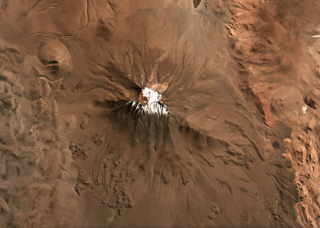Report on Aracar (Argentina) — April 1993
Bulletin of the Global Volcanism Network, vol. 18, no. 4 (April 1993)
Managing Editor: Edward Venzke.
Aracar (Argentina) Ash column reported
Please cite this report as:
Global Volcanism Program, 1993. Report on Aracar (Argentina) (Venzke, E., ed.). Bulletin of the Global Volcanism Network, 18:4. Smithsonian Institution. https://doi.org/10.5479/si.GVP.BGVN199304-355160
Aracar
Argentina
24.29°S, 67.783°W; summit elev. 6095 m
All times are local (unless otherwise noted)
A steam plume was observed rising above Arácar on 28 March. Viewed from the town of Tolar Grande, 50 km SE, the plume persisted throughout the clear day. At least twice during the day, a large ash column slowly rose 2,000 m above the summit. The following day clouds prevented a clear view of the volcano, but an "ashy haze" in the sky was noted. A local observer indicated that the activity was not unusual.
Arácar has a base 10 km in diameter. It is located just E of the Argentina-Chile border, ~ 100 km S of Lascar and 80 km NE of Llullaillaco volcanoes. No historical eruptions have been recorded. Moyra Gardeweg provided the following background. "It is clearly younger than the surrounding Miocene volcanoes. Its steep conical edifice has been cut by some deep gorges and an uncovered alteration zone lies close to its summit on the NE flank. It has a well-developed and well-preserved summit crater (1-1.5 km diameter) that contains a tiny lake. Lava flows are well preserved at the base of the cone (below 4,500-m elev), a common feature of Pliocene-to-Quaternary volcanoes in the Central Andes. I have no information about its exact age, but the good preservation of the summit crater and lava flows suggest that it could be Quaternary, although I can only assume it is Pliocene or younger."
Geological Summary. Aracar is a steep-sided stratovolcano with a youthful-looking summit crater 1-1.5 km in diameter that contains a small lake. It is located just east of the Argentina-Chile border. The volcano was constructed during three eruptive cycles dating back to the Pliocene. The andesitic stratovolcano overlies dacitic lava domes. Lava flows found at the base of the volcano below 4500 m elevation are relatively well preserved, but upper-flank lavas, often an indication of youthful activity, are not present (de Silva, 2007 pers. comm.). There were reports of possible ash columns from the summit in 1993, but it is not known whether these were rockfall dust or eruption plumes.
Information Contacts: R. Trujillo, Colorado, USA; M. Gardeweg, SERNAGEOMIN, Santiago.

